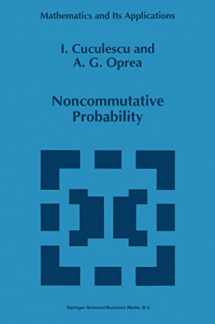
Noncommutative Probability (Mathematics and Its Applications, 305)
ISBN-13:
9789048144709
ISBN-10:
9048144701
Edition:
Softcover reprint of the original 1st ed. 1994
Author:
I. Cuculescu, A.G. Oprea
Publication date:
2010
Publisher:
Springer
Format:
Paperback
368 pages
Category:
Applied
,
Mathematical Analysis
,
Mathematics
,
Mathematical Physics
,
Physics
FREE US shipping
Book details
ISBN-13:
9789048144709
ISBN-10:
9048144701
Edition:
Softcover reprint of the original 1st ed. 1994
Author:
I. Cuculescu, A.G. Oprea
Publication date:
2010
Publisher:
Springer
Format:
Paperback
368 pages
Category:
Applied
,
Mathematical Analysis
,
Mathematics
,
Mathematical Physics
,
Physics
Summary
Noncommutative Probability (Mathematics and Its Applications, 305) (ISBN-13: 9789048144709 and ISBN-10: 9048144701), written by authors
I. Cuculescu, A.G. Oprea, was published by Springer in 2010.
With an overall rating of 4.1 stars, it's a notable title among other
Applied
(Mathematical Analysis, Mathematics, Mathematical Physics, Physics) books. You can easily purchase or rent Noncommutative Probability (Mathematics and Its Applications, 305) (Paperback) from BooksRun,
along with many other new and used
Applied
books
and textbooks.
And, if you're looking to sell your copy, our current buyback offer is $0.3.
Description
The intention of this book is to explain to a mathematician having no previous knowledge in this domain, what "noncommutative probability" is. So the first decision was not to concentrate on a special topic. For different people, the starting points of such a domain may be different. In what concerns this question, different variants are not discussed. One such variant comes from Quantum Physics. The motivations in this book are mainly mathematical; more precisely, they correspond to the desire of developing a probability theory in a new set-up and obtaining results analogous to the classical ones for the newly defined mathematical objects. Also different mathematical foundations of this domain were proposed. This book concentrates on one variant, which may be described as "von Neumann algebras". This is true also for the last chapter, if one looks at its ultimate aim. In the references there are some papers corresponding to other variants; we mention Gudder, S.P. &al (1978). Segal, I.E. (1965) also discusses "basic ideas".


We would LOVE it if you could help us and other readers by reviewing the book
Book review

Congratulations! We have received your book review.
{user}
{createdAt}
by {truncated_author}


